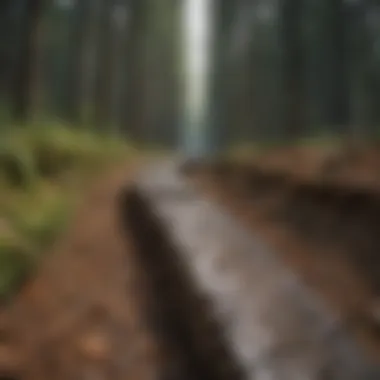Innovative Solutions for Steep Slope Stabilization


Intro
Steep slope stabilization is an important aspect of environmental management. The approaches and products used address critical challenges presented by steep terrains. Understanding the implications of these products is essential for forestry professionals and academics alike. The goal of this article is to explore the intersection of technology and ecological stewardship in stabilizing steep slopes effectively.
Understanding Woodland Ecosystems
To comprehend the value of steep slope stabilization, one must first appreciate the underlying dynamics of woodland ecosystems.
Importance of Biodiversity in Forests
Forests house an immense variety of life forms. This biodiversity contributes to ecosystem resilience. Various plant and animal species interact within these ecosystems, providing stability. Each species plays its part in nutrient cycling, pollination, and soil formation. The loss of biodiversity can lead to weakened ecosystems, making them more susceptible to erosion and landslides, particularly on steep slopes.
Role of Forests in Climate Regulation
Forests significantly impact climate regulation. They sequester carbon dioxide, helping mitigate climate change. With steep slopes, forests can stabilize soil and water systems. The foliage reduces run-off and soil erosion. Practices that destabilize these areas not only threaten biodiversity but also hinder forest functions essential for climate health.
Sustainable Forestry Practices
Engaging in sustainable forestry practices is vital for long-term stability and health of steep slopes.
Principles of Sustainable Forestry
Sustainable forestry emphasizes maintaining ecosystem integrity, function, and biodiversity. This involves minimal intervention and respecting ecological processes. Adopting practices like selective logging can reduce the impact on steep slopes while ensuring wood production remains viable. Encouraging natural regeneration is another pillar of sustainable forestry, allowing natural habitats to flourish.
Case Studies of Successful Implementations
Several case studies illustrate the effectiveness of sustainable forestry practices. For example, the use of controlled burns in North America prevents larger, uncontrolled wildfires, preserving steep areas. These methods ensure that forests remain resilient and biodiversity is supported. Other regions have adopted agroforestry approaches, integrating trees with crops. This practice helps stabilize slopes while enhancing food security.
Woodland Stewardship Techniques
Appropriate stewardship techniques are crucial for managing steep slopes.
Forest Management Plans
Developing comprehensive forest management plans is essential. These plans outline strategies for reforestation, pest management, and erosion control. Incorporating local community insights can enhance effectiveness. Engaging stakeholders ensures that stewardship practices are accepted and sustainable.
Conservation Strategies
Implementing conservation strategies is another vital aspect. These can include creating buffer zones around waterways and maintaining genetic diversity in tree species. Protecting specific habitats aids in preserving biodiversity on steep slopes. The integration of these strategies enhances the stability of the entire ecosystem.
Effective slope stabilization requires a holistic approach that considers biodiversity, climate impact, and sustainable practices.
By adopting these perspectives and implementing innovative products, we can better equip ourselves to tackle the challenges posed by steep slopes. Understanding and applying these concepts will guide professionals in making informed decisions for forestry and land management.
Prelims
Steep slope stabilization plays a critical role in managing land and protecting ecosystems. Its importance cannot be understated in the context of forestry and land management. When dealing with steep terrains, the risk of erosion or landslides increases significantly. Therefore, implementing effective stabilization techniques is essential for maintaining environmental balance and ecosystem health.
Erosion can lead to loss of soil and vegetation, negatively impacting forest health and biodiversity. Furthermore, in forestry, stabilizing slopes can enhance water retention and absorption, which is vital for the growth of trees and other plants. By controlling erosion, professionals can also ensure better access to these areas for management and harvesting purposes.
In this article, we will explore the different types of products available, their functionalities, and the benefits they provide. We will also discuss the selection criteria essential for making informed choices. As we delve deeper, we will shed light on innovative techniques and emerging trends that promise enhancements in slope stabilization practices. In doing so, we aim to offer forestry professionals and academics an informed perspective on this important topic, facilitating better decision-making.
Understanding Slope Stability
Slope stability is intrinsically linked to the forces acting on a slope and its materials. A stable slope is one where the forces attempting to make the slope fail are less than the forces keeping it intact. Factors such as soil type, water content, and vegetation play crucial roles in this balance. For instance, dry soil has a higher shear strength, whereas saturated soil can become unstable and prone to sliding.
In addition, the geometry of a slope, including its angle and height, plays a fundamental role in stability. Steeper slopes are generally more prone to instability. Landslides can occur due to changes in these factors, such as increased rainfall or human activities like logging. This understanding is foundational for implementing effective stabilization products.
Importance of Stabilization in Forestry


In forestry, slope stabilization is vital for several reasons. First, it aids in preventing soil erosion, which can lead to the degradation of forest lands. The loss of topsoil not only reduces the land's productivity but also impacts water quality in nearby streams and rivers. By implementing stabilization measures, forestry professionals can mitigate these risks.
Second, stable slopes promote healthy plant growth. When slopes are preserved, trees can root more effectively, leading to robust growth and resilience to environmental stresses. This benefits not only the trees themselves but also the various species that depend on them.
Finally, maintaining slope stability is crucial for infrastructure protection. Roads, trails, and facilities in forested areas are often at risk due to potential landslides. Effective stabilization solutions help ensure that these infrastructures remain safe and operational. Overall, the significance of slope stabilization extends beyond just forest management; it encompasses environmental, economic, and social considerations.
Overview of Steep Slope Stabilization Products
Steep slope stabilization is an essential aspect of environmental management, particularly in forestry. The increased risk of landslides and erosion in steep terrains necessitates effective solutions to maintain land and ecological integrity. Therefore, understanding available stabilization products is crucial for forestry professionals and land managers. This section delves into the various types of stabilization products, their functional mechanisms, and why they matter.
Types of Products Available
Geotextiles
Geotextiles are permeable fabrics that provide numerous benefits in slope stabilization. Their key characteristic is their ability to separate soil layers while allowing water to pass through. This quality prevents soil erosion while promoting drainage, making geotextiles a popular choice for various projects. One unique feature of geotextiles is their versatility; they can be used in various applications, including road construction and land reclamation. Their advantages include ease of installation and many options tailored to different soil conditions. However, geotextiles may require additional components for optimal performance in highly erosive environments.
Retaining Walls
Retaining walls play a vital role in stabilizing slopes by counteracting the lateral pressure of soil. Their primary characteristic is their structural support, which helps to maintain the integrity of steep terrains. Retaining walls are beneficial as they provide immediate and effective stabilization, preventing soil movement and erosion. A unique aspect of these walls is their design; they can be made from concrete, stone, or other materials, allowing for adaptability to specific project needs. On the downside, retaining walls can be costly and may require professional expertise for construction and maintenance.
Hydroseeding Equipment
Hydroseeding equipment applies a slurry of seed, mulch, and fertilizers to promote vegetation growth on slopes quickly. Its key characteristic is the efficiency with which it can cover large areas, allowing for faster vegetation establishment than traditional seeding methods. This makes hydroseeding a popular choice for immediate erosion control in steep areas. A unique advantage is that it minimizes soil disturbance, ensuring better seed contact with the soil. Nevertheless, the effectiveness of hydroseeding depends on weather conditions and may not work as well on very steep or unstable surfaces.
Natural Fiber Products
Natural fiber products consist of biodegradable materials like coir and jute. Their primary role is reinforcing soil, thus enhancing slope stability. These products are becoming increasingly popular due to their eco-friendly nature, which aligns with sustainability goals in forestry practices. A key feature of natural fiber products is their ability to integrate with soil over time, improving soil structure and promoting long-term stabilization. However, while they offer significant advantages in environmental impact, their initial effectiveness can vary based on conditions and the type of fibers used.
Functional Mechanisms
Weight Redistribution
Weight redistribution mechanisms help to mitigate the forces acting on steep slopes. Their key feature lies in their ability to shift the load of soil or other materials, reducing pressure on a specific area. This is beneficial as it enhances overall slope stability. An important aspect of weight redistribution is its adaptability, which can be implemented in various designs, such as soil nailing or terracing. Nevertheless, the need for careful engineering and design means that not all projects can benefit equally from this technique.
Surface Stabilization
Surface stabilization involves techniques that reinforce the top layer of soil, preventing erosion. Its key characteristic is enhancing soil cohesion through means like chemical stabilization or surface treatments. This method is particularly beneficial for maintaining the integrity of access roads and other infrastructure on steep slopes. Surface stabilization's unique feature is its ability to be tailored to specific soil types and conditions. However, it may not provide as robust protection as other stabilization methods in areas facing severe erosion.
Vegetative Reinforcement
Vegetative reinforcement employs plants to stabilize soil on steep slopes. Its primary characteristic is its ability to establish root systems that bind soil particles together. This method is advantageous because it promotes biodiversity and contributes to the overall health of the ecosystem. A unique feature of vegetative reinforcement is its natural method of erosion control, which integrates ecological processes. However, one must be cautious about plant selection, as inappropriate species could fail to establish and provide the necessary reinforcement.
Benefits of Steep Slope Stabilization Products
Steep slope stabilization is more than just a preventive measure. It's a comprehensive approach to land management that carries several benefits. Understanding these advantages is crucial for forestry professionals and academics alike. The effects of utilizing steep slope stabilization products extend beyond immediate aesthetic improvements, touching on ecological stability and infrastructure longevity.
Erosion Control
Erosion control is one of the primary benefits of steep slope stabilization products. Soil erosion can have devastating effects on land productivity and water quality. When soil is washed away, not only is the land rendered less useful for forestry, but the sediment can also pollute nearby water bodies. Products such as geotextiles help keep soil in place by offering a supportive layer that prevents runoff.
- Geotextiles: They provide a barrier against erosion, allowing vegetation to establish, which further solidifies the soil.
- Hydroseeding Equipment: This method ensures a quick and effective way to promote plant growth on slopes, reducing the risk of erosion as vegetation takes root.
"Investing in erosion control measures safeguards our natural resources and creates sustainable landscapes."
Enhancing Biodiversity
Slope stabilization has a direct correlation to enhancing biodiversity in forested areas. By stabilizing steep slopes, you create conditions for various plant and animal species to thrive. Furthermore, products such as natural fiber products promote the growth of native vegetation, which contributes to a balanced ecosystem. This is essential because:
- Diverse Habitat: Stabilized slopes create habitats for multiple species, enhancing flora and fauna variety.
- Increased Soil Health: Healthy plant life improves soil structure, nutrient availability, and water retention, benefiting the entire ecosystem.
Infrastructure Protection


The protection of infrastructure is another vital benefit of steep slope stabilization products. Many communities and forestry operations face the risk of landslides and soil collapse during heavy rainfall or other extreme weather. Retaining walls, specifically designed for steep terrains, serve to hold back the soil, preventing catastrophic failures.
- Reduced Repair Costs: By preventing erosion and landslides, the need for expensive repairs or modifications to infrastructure is significantly lessened.
- Enhanced Safety: Stabilized slopes reduce potential hazards for both workers and wildlife, contributing to overall safety in forestry operations.
Overall, recognizing the benefits of steep slope stabilization products equips professionals with the knowledge to make informed decisions in land management. Erosion control, biodiversity enhancement, and infrastructure protection are just a few reasons these products play an essential role in modern forestry practices.
Selection Criteria for Stabilization Products
Choosing the right stabilization products for steep slopes is a critical process that requires meticulous consideration of various factors. The effectiveness of these products in addressing slope stability directly impacts both environmental and structural integrity. This section delves into essential elements that must be assessed when selecting slope stabilization solutions.
Site Assessment
Site assessment forms the foundation of an effective stabilization strategy. Understanding the specific conditions and characteristics of the site, including topography, drainage patterns, and existing vegetation, is paramount. Conducting a thorough site evaluation enables professionals to determine the most suitable products and techniques for slope stabilization.
Technical tools can assist in this assessment. Using tools like topographic maps, soil tests, and hydrological studies can provide valuable insights into site conditions. For instance, areas with high moisture levels may need products that enhance drainage and reduce erosion.
Soil Type Considerations
Soil type plays a significant role in the selection of stabilization products. Different soil compositions have distinct stability challenges. For example, sandy soils exhibit higher erosion rates while clayey soils are more prone to water retention, leading to increased pressure on slopes. Thus, understanding soil characteristics aids in choosing compatible products that will function effectively in the given environment.
A thorough soil analysis can guide one in selecting bioengineering solutions, geotextiles, or other techniques that align well with the natural properties of the soil. Each type of soil may require a specific approach, making this consideration crucial in the decision-making process.
Environmental Impact
Considering the environmental implications of stabilization products is essential. It is important to choose products that minimize negative impacts on the ecosystem. Two primary aspects to evaluate under environmental impact are chemical compatibility and degradation effects.
Chemical Compatibility
Chemical compatibility examines how stabilization products interact with the site's ecological components. Selecting products that are not harmful to soil organisms and vegetation is vital. A key characteristic of chemical compatibility is its ability to prevent adverse reactions that could disrupt biological processes, making it a beneficial choice for sustainable practices in slope stabilization.
Moreover, products with high chemical compatibility help maintain soil health and promote the growth of native plants, enhancing biodiversity. Avoiding chemically harsh materials ensures a positive contribution to the ecological balance, thereby supporting the goal of sustainable forestry practices.
Degradation Effects
Degradation effects refer to how stabilization products may break down or alter over time. Understanding these effects is crucial as they can influence the long-term effectiveness of the chosen products. A key characteristic of degradation effects is that they can either contribute to failure or enhance efficacy, depending on the product's material and design.
For example, natural fiber products can degrade over time, which may be advantageous in promoting soil health but might require careful management to ensure continual stabilizing effects. This characteristic has both advantages and disadvantages; while natural degradation can benefit the ecosystem, it may necessitate more frequent assessments and interventions to maintain slope stability over time.
"The selection of stabilization products is not merely about immediate effectiveness but also long-term ecological impacts."
These considerations underscore the importance of thorough evaluation in the selection process. Informed decisions regarding slope stabilization products must balance immediate functionality with long-term sustainability.
Innovative Techniques for Slope Stabilization
Innovative techniques in slope stabilization play a vital role in managing steep terrains effectively. These methods harness new concepts and technologies that not only address stability issues but also enhance environmental sustainability. The ongoing evolution of these techniques reflects a growing awareness of ecological challenges and the need for proactive solutions. Implementing innovative strategies can help in achieving long-term stabilization while minimizing environmental impacts.
Bioengineering Solutions
Bioengineering solutions involve the integration of biological organisms into slope stabilization efforts. This approach uses plants and other living materials to reinforce soil stability. The roots of various vegetation varieties can hold soil particles together, reducing erosion significantly. Bioengineering not only stabilizes the slopes but also promotes vegetation growth, leading to improved biodiversity in the area.
- Benefits: Some key advantages of bioengineering include enhanced aesthetic value, improved soil health, and natural habitat creation. Moreover, using plants can aid in filtering pollutants from runoff, thus contributing positively to water quality.
- Considerations: While implementing these solutions, careful selection of plant species is crucial. Factors such as local climate, soil type, and ecological conditions must be considered to ensure successful growth and sustainability.
Use of Technology and Software
The role of technology and software in slope stabilization cannot be overstated. These tools facilitate better planning and execution of slope stabilization projects. They assist in data collection, analysis, and modeling of slope behavior under various conditions. Utilizing advanced technologies aids in the identification of potential risks and helps in devising effective strategies.
Modeling and Simulation Tools
Modeling and simulation tools are essential for predicting slope responses to various scenarios. These digital applications allow engineers and forestry professionals to visualize how different stabilization products will perform over time. A significant characteristic of these tools is their ability to simulate real-world conditions, providing a reliable forecast for practitioners.
- Benefits: The predictive capability of modeling tools contributes to greater accuracy in project planning. They help in optimizing the choice of stabilization products based on site-specific characteristics, resulting in cost-effective solutions.
- Considerations: However, these tools require a certain level of expertise to operate effectively. Underestimating the learning curve can lead to improper use, ultimately affecting project outcomes.


Remote Sensing Applications
Remote sensing applications leverage satellite imagery and aerial data to analyze slope conditions comprehensively. This technique provides significant insights into large-scale terrestrial changes. The main benefit of remote sensing is its ability to monitor slopes without the need for physical intervention, which is often impractical in steep or hazardous areas.
- Benefits: It enables continuous monitoring of slopes, offering real-time data that can inform management decisions. Additionally, these applications can help in identifying areas that may require immediate attention due to signs of potential failure.
- Considerations: While remote sensing can vastly improve slope management, reliance solely on technology is a limitation. Ground truthing is often necessary to confirm findings from remote data, ensuring a balanced approach to stabilization efforts.
Challenges in Implementing Stabilization Products
The application of stabilization products for steep slopes comes with several challenges that must be meticulously addressed. Understanding these obstacles is vital for forestry professionals and decision-makers in the land management sector. Each challenge brings its own set of implications, influencing the effectiveness and sustainability of slope stabilization efforts. By identifying these challenges upfront, stakeholders are better equipped to find viable solutions and ensure the successful implementation of these products.
Cost Implications
The cost associated with slope stabilization products can be significant. From initial purchase to ongoing maintenance, financial considerations must be prioritized. The price varies widely depending on the type of product and the scale of the project. For example, ecological solutions like natural fiber products may have lower material costs but require labor-intensive installation, causing overall expenses to rise.
- Investment Assessment: Forestry professionals need to conduct a thorough cost-benefit analysis, weighing immediate expenses against long-term environmental benefits. Although some products may seem pricier initially, their durability and efficiency can offer savings over time.
- Budget Constraints: Many organizations face budgeting challenges and may not allocate sufficient funds for slope stabilization successfully. This may result in using subpar materials or delaying necessary interventions, ultimately leading to greater expenses due to erosion damage.
Technical Expertise Requirements
The implementation of steep slope stabilization products often requires a level of expertise that may not be readily available. Skilled labor and knowledgeable personnel are crucial for effective application. Lack of expertise can lead to improper installation, reducing the effectiveness of the products.
- Training Necessities: Organizations must invest in training programs to equip staff with the necessary skills to handle modern stabilization products. Technical workshops or partnerships with experienced consultants can provide invaluable guidance.
- Continual Learning: The field of slope stabilization is evolving. Thus, professionals need to stay updated on the latest methods and technologies. This continual learning approach can often require significant time and resources.
Regulatory Considerations
Navigating regulatory frameworks presents another challenge for the implementation of stabilization products. Strict regulations often dictate what methods and materials can be used, particularly in environmentally-sensitive areas.
- Compliance with Environmental Laws: Organizations must understand local, state, and federal environmental regulations. Non-compliance can lead to penalties, project delays, and reputational damage.
- Permitting Processes: The process of obtaining the necessary permits may be lengthy, requiring extensive documentation and justification for chosen methods. This impacts project timelines and budget considerations.
"Addressing the complexities of cost, technical expertise, and regulatory hurdles is essential for the successful implementation of slope stabilization products."
Future Directions in Slope Stabilization
The future directions in slope stabilization are pivotal to ensuring the integrity and sustainability of steep slope environments. As land management practices continue to evolve, it becomes crucial to incorporate innovative strategies and emerging technologies. This evolution is not only about enhancing efficacy but also about aligning with ecological principles. The intersection of innovation and sustainability offers numerous benefits that can profoundly impact forestry practices and environmental stewardship.
Emerging Technologies
Emerging technologies are reshaping the landscape of slope stabilization. The application of advanced tools, such as drones and Geographic Information Systems (GIS), provides valuable insights. These technologies facilitate precise mapping and monitoring of slopes, allowing for better data collection on potential risks. They can identify erosion areas or regions prone to landslides. Likewise, the integration of sensors into slope stabilization products enables real-time monitoring. This helps provide immediate feedback about slope conditions, improving proactive measures against failures.
Another noteworthy addition is the development of smart materials. These materials can adapt to environmental conditions, enhancing their effectiveness in steep slope stabilization. For instance, phase-change materials can control temperature variations, thereby maintaining the integrity of the slope. Furthermore, bio-inspired designs and practices are gaining attention. Researchers are studying natural systems to develop innovative solutions inspired by these ecosystems. Such approaches could lead to more resilient and sustainable slope management techniques.
Sustainable Practices
Sustainable practices are critical in shaping future slope stabilization efforts. These practices prioritize ecological health alongside stabilization goals. One notable method is the integration of native vegetation in stabilization projects. By using plants that are naturally adapted to the local environment, they enhance soil health and minimize erosion. This adds biodiversity and aids in the long-term resilience of steep slopes.
Implementing low-impact development principles is another effective strategy. Techniques such as rain gardens and bioswales can mitigate the impact of water runoff. These practices manage stormwater efficiently, reducing the risk of slope failure. They also help replenish groundwater, contributing to a more sustainable ecosystem overall.
"Incorporating sustainable practices not only addresses human needs but also respects and preserves ecological systems."
Community engagement plays a vital role in future slope stabilization. Stakeholders, including local communities, can provide valuable insights into effective practices and local knowledge. Educating these communities about the importance of slope stability enhances collaboration in implementing sustainable initiatives.
Epilogue
The conclusion marks a vital part of this article, synthesizing insights on steep slope stabilization products. It is essential to recognize the multifaceted role these products play in environmental management and forestry practices. As discussed, the challenges posed by steep slopes are significant, influencing erosion, infrastructure integrity, and biodiversity. Therefore, understanding, selecting, and implementing appropriate stabilization methods is imperative for both ecological health and economic viability.
Summary of Key Points
In this article, we have delved into various aspects of slope stabilization, which include:
- Understanding Slope Stability: The foundational principles that dictate slope integrity.
- Types of Products Available: An overview of diverse offerings such as geotextiles, retaining walls, hydroseeding equipment, and natural fiber products, each tailored to specific stabilization needs.
- Functional Mechanisms: Explored how weight redistribution, surface stabilization, and vegetative reinforcement contribute to effective stabilization.
- Benefits of Stabilization Products: Demonstrated how these products control erosion, enhance biodiversity, and protect infrastructure.
- Selection Criteria: Detailed evaluation of site assessment, soil type, and environmental impact, particularly the significance of chemical compatibility and degradation effects.
- Innovative Techniques: Insights into bioengineering solutions and the application of technology in modeling, simulation, and remote sensing.
- Challenges: Highlighted implications related to cost, technical know-how, and regulations.
- Future Directions: Discussed emerging technologies and sustainable practices poised to revolutionize slope stabilization.
The Path Forward in Forestry Practices
The path forward in forestry practices relies on integrating modern techniques and sustainable approaches. As our understanding of ecological dynamics evolves, forestry professionals should embrace innovative solutions and products designed to stabilize steep slopes effectively. Forward-thinking practices can involve:
- Adopting Technology: Utilization of advanced software for modeling scenarios and predicting outcomes can enhance decision-making.
- Focus on Sustainability: Implementing eco-friendly products that minimize environmental impact will ensure the longevity of forestry practices.
- Continuous Assessment and Training: Keeping abreast of new tools and methodologies through ongoing training and site assessments ensures adaptability in varied conditions.
- Collaboration: Engaging all stakeholders in the stabilization process encourages sharing of knowledge and experience, thereby improving overall forest management.
Thoughtful application of stabilization products and awareness of their implications on the ecosystem is crucial. As professionals advance, ensuring that practices align with principles of sustainability and ecology should remain at the forefront of forestry operations.







